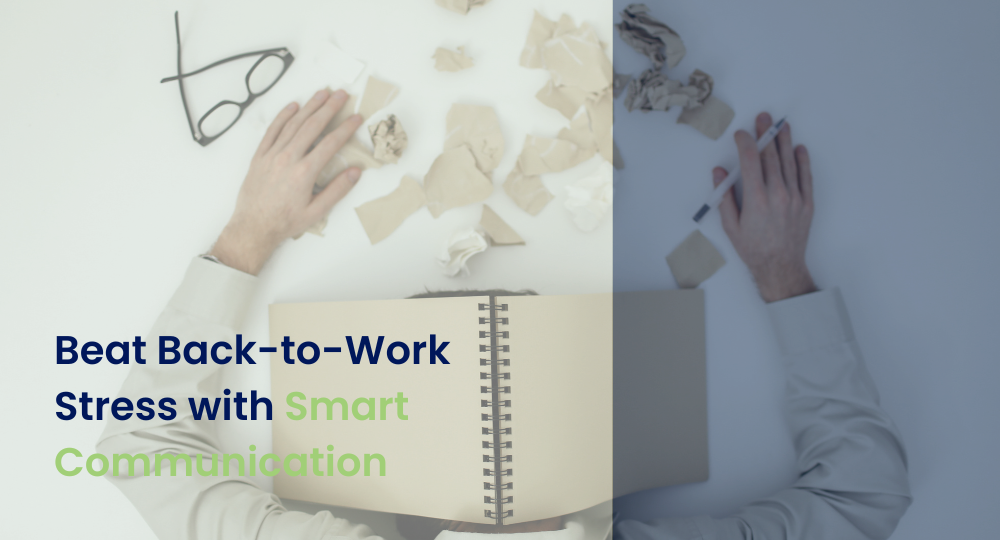September has a particular flavor. The long days of summer fade, mornings feel cooler, and suddenly reality hits: no more flip-flops, it’s back to proper shoes and office outfits. The inbox is overflowing, the commute feels longer than you remember, and your coffee machine has turned into your best ally. Add to that the juggling act of kids’ activities, school pick-ups, and after-work groceries — all while trying to smile at colleagues you’re not exactly thrilled to see every day.
It’s no wonder many professionals are looking for ways to create a stress-free return to work and keep their energy intact.
Why the Return to Work Feels So Stressful
After weeks of freedom and slower rhythms, returning to daily work life can feel overwhelming. Common challenges include:
Stress of catching up: overflowing inboxes and back-to-back meetings.
Loss of freedom: no more late mornings or spontaneous beach days.
Commute fatigue: traffic, crowded trains, or long drives.
Social overload: seeing colleagues every day, navigating office dynamics.
Acknowledging these challenges is the first step to overcoming them. Everyone experiences the transition differently, and this is exactly where PCM provides an edge.
Understanding the Human Side of Transition
PCM reminds us that stress doesn’t affect everyone in the same way. Each of us has different personality needs and stress triggers. Some people crave recognition for their work and feel discouraged when it goes unnoticed. Others need structure to feel safe, or variety to avoid boredom. When these needs aren’t met, especially during stressful times like September, negative emotions and miscommunication rise.
PCM also highlights that there are 6 types of communication processes, each one triggering different emotional responses and fulfilling specific psychological needs. The magic happens when you know which one to use with whom: asking for opinions, creating intimacy, exchanging facts, inviting action, or sparking humor. Recognizing this diversity is powerful. Instead of blaming yourself – “Why am I so unmotivated?” or others – “Why are they so tense?”, PCM helps you see that everyone reacts based on their unique personality structure — and that you can adapt your words to create balance and reduce stress.

Turning Stress into Strength During the Return to Work
When routines restart, it’s easy to feel like you’re running on empty. Some people crave recognition for their work and feel drained when it’s missing. Others need structure to feel safe, or variety to avoid boredom. When these core needs go unmet, stress shows up quickly: impatience in meetings, tension at home, or that heavy feeling of ‘I can’t keep up’ — a reminder of how important balancing work and personal life really is.
Noticing these patterns early is half the battle. Ask yourself:
What do I need most right now to feel energized?
Am I missing clarity, recognition, fun, or time to breathe?
How might my colleagues’ needs be different from mine?
By paying attention to these signals — both yours and others’ — you can adjust how you communicate and interact. That might mean giving more detailed context to a colleague who thrives on structure, showing warmth to someone who needs connection, or lightening the mood when the atmosphere gets too tense.
And here’s the key: when you recognize and respect these differences, the usual power struggles of the post-holiday period – managers demanding quick results, teammates negotiating workloads – can shift. Instead of fueling conflict, communication becomes a way to rebuild collaboration and resilience.
A stress-free return to work doesn’t mean the absence of pressure. It means knowing how to adapt, so everyone feels seen and supported.
Practical Tips to Beat the Back-to-Work Blues
Here are simple strategies you can apply today:
1 – Know your Base Type: Start by identifying what motivates you. If you’re a Thinker Base, create a structured plan for your first week back. If you’re a Rebel Base, inject humor and playfulness into your day.
2 – Refill your psychological “tank”: Ask yourself daily: Did I get the recognition or stimulation I need? If not, take a moment to meet that need.
3 – Adapt to colleagues: Notice how your teammates communicate. A person with a lot of Persister energy may need their opinions acknowledged; when people with high Harmonizer energy level will appreciate warmth and kindness.
4 – Break the routine creatively: Add micro-breaks, change your commute playlist, or plan lunch outside with colleagues. Small changes make the transition lighter.
5 – Practice OKness: PCM emphasizes the idea that “I’m OK, You’re OK.” Keep this mindset to handle stress with empathy instead of frustration.

Ready to Make September Stress-Free?
Going back to work doesn’t have to feel heavy. With PCM, you can understand your stress triggers, adapt your communication, and create a smoother, more positive transition, for yourself and your colleagues.
👉 Take the next step:
– Discover your unique personality structure with a PCM Profile. Deepen your skills in the PCM Core Topics training and learn how to navigate stress with confidence.
– Let September be more than the end of summer. It can be the beginning of a more connected, resilient, and motivated you.
Learn more about
A Milestone for PCM Research: How Our Personality Shapes Emotional Responses in Communication
Date: October 20, 2025
PCM and Breast Cancer Awareness: A Story of Renewal
Date: October 9, 2025
PCM and Impostor Syndrome: Break the Cycle of Self-Doubt
Date: October 8, 2025
PCM Training Industry Partnership: A Game-Changer
Date: September 22, 2025
Pixar Process Communication Model: Storytelling Secrets
Date: September 16, 2025
PCM 2025 Conference: Human Connection in Action
Date: September 5, 2025



